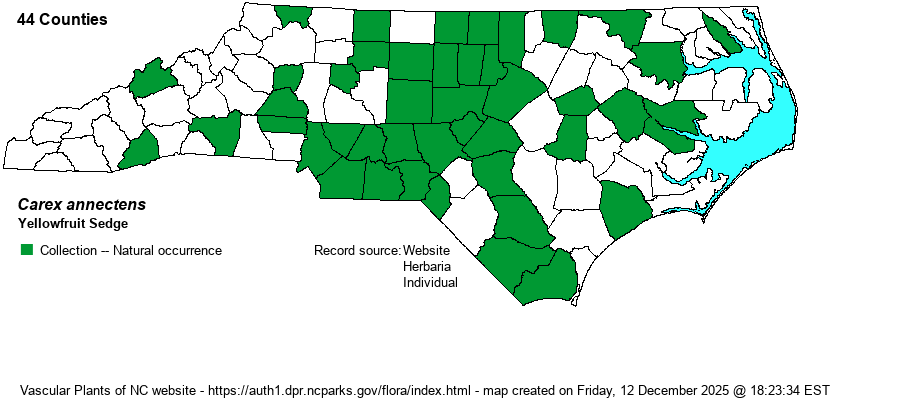| Author | (Bicknell) Bicknell | |
| Distribution | Primarily in the middle and lower Piedmont, extending along the Cape Fear River to Brunswick County. Scattered records in the upper Piedmont, Mountains, and remainder of the Coastal Plain.
ME to MN south to FL and TX. | |
| Abundance | Fairly common in the central and eastern Piedmont, but mostly uncommon elsewhere in the Piedmont and Coastal Plain; very rare in the Mountains. Tends to occur in small populations scattered on the landscape. The often numerous culms (of a single plant) give the impression of many plants. | |
| Habitat | Dry to moist fields, meadows, forest openings, roadsides, powerlines, bottomland forests, marshes. Usually in less wet habitats than C. vulpinoidea, but habitats overlap. A great array of moist to rather dry habitats, shaded and open; can be weedy. Considering its wide array of habitats, it is surprising that it is not more common, and the fact that many Coastal Plain records are from along brownwater rivers suggest that it favors somewhat high pH soil. | |
| Phenology | Flowering and fruiting July-August. | |
| Identification | Yellowfruit Sedge stems grow mostly 1.5-2.5 feet tall, with a terminal, linear, dense spike of perigynia. The golden yellow or brownish yellow pergynia, and flowering stems longer than leaves, separate it from C. vulpinoidea which has pale brown or dull yellow-green perigynia and flowering stems shorter than the leaves. | |
| Taxonomic Comments | Includes var. xanthocarpa.
The genus Carex is the largest in North America, and among the largest in the world. In temperate and boreal regions, Carex is often the dominant or co-dominant ground layer in many habitats. Seeds (achenes) are valuable food for birds and small mammals, while foliage is used by birds and mammals to make nests and as food by mammals. Species of Carex often look vastly different from one another -- spikes erect vs. drooping, tiny inflorescence vs. whopping, culms leafy vs. naked, perigynia beaked vs. beakless, stems densely bunched vs. single, etc. The genus has been divided into many sections (or groups), based on shared characters; some taxonomists have suggested that these be different genera, but that proves unworkable (so far). All Carex share the feature of a perigynium (an outer covering) which completely surrounds the achene (seed). This covering may fit tightly or loosely (like a small bladder), depending on which group or species. Details of perigynia shape, ornamentation, presence and size of beak, number of striations (or veins) are all important ID features. In recent years Rob Naczi and colleagues have stressed the importance of arrangement of perigynia -- whether spiral (3+ ranks) or distichous (2-ranked) -- and have named a number of new species as well as split off some older synonyms. Therefore, RAB's (1968) key, excellent for its time, can only be used in a general way today. Members of some sections of Carex are difficult to key out (notably Ovales, Laxiflorae, Griseae); this is in part due to variation among individuals of a species, or failings of the key. FNA has drawings of most species and some species may be found in two or more places within a key, to acount for variability. New species to NC, and new to science(!), continue to be found in NC. | |
| Other Common Name(s) | Yellowfruit Fox Sedge | |
| State Rank | S3 [S4] | |
| Global Rank | G5 | |
| State Status | | |
| US Status | | |
| USACE-agcp | FACW link |
| USACE-emp | FACW link |

